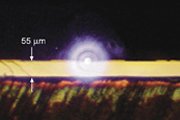Researchers are striving to create photonic microcircuits that can manipulate photons as deftly as today’s microchips manipulate electrons. Light signals offer the potential for more-efficient information processing. Now, engineers have found a way to extend one of the most advanced capabilities in electronics directly into the photonics realm.

A team at the University of Illinois at Urbana-Champaign that previously developed some of the world’s fastest electronic transistors has modified its record-setting technology to create a practical device that’s both an electronic transistor and an infrared laser, a photonic component.
Ten months ago, the team unveiled a prototype transistor laser, but it had to be cooled to –73°C to work (SN: 11/20/04, p. 324). In the Sept. 26 Applied Physics Letters, the team reports the first transistor laser that functions at room temperature. “We haven’t compromised any of the high-speed aspects of the transistor to get there,” notes team member Nick Holonyak Jr.
Although the new device can switch on and off at only the modest frequency of
3 gigahertz, frequencies 100 times as rapid as that appear feasible, Holonyak says. The upshot could be blazingly fast optical-fiber telecommunications and computers.







